Generation of Multiple Focal Hole Segments Using Double-Ring Shaped Azimuthally Polarized Beam
Abstract
We investigated the focusing properties of a double-ring-shaped azimuthally polarized beam tightly focused with a high NA lens and a binary phase filter. We observe that by using 3 belts and 5 belts binary phase filters novel focal patterns including splitting of focal rings and multiring focus are obtained. We also found that a suitably designed phase structure can shift the focal rings along optical axis. The author expects such investigation is worthwhile for optical manipulation and material processing technologies.
1. Introduction
Growing interest in the generation of three-dimensional (3D) optical beams that are dark regions in space surrounded by light is driven by wide ranging applications including dark optical traps for atoms [1], manipulation, guiding and binding of microparticles and biological cells [2], and erase beams for super-resolution fluorescence microscopy [3]. Such beams are also known as twice-closed tubular optical structure (TCTOS) [4], optical bubbles [5], and hollow dark spherical spots [6]. Optical beams with oscillating on-axis intensity due to interference resulting in 3D intensity voids and 3D optical chains were proposed recently for trapping of multiple particles along the beam propagation and for controllable particle delivery [7]. Over the past years, a variety of techniques have been proposed for generating such optical bottle beams for applications in optical tweezers and atom traps [8–15]. Recently, a subwavelength focal hole (~0.5λ) with a quite long depth of focus (~48λ) is achieved near the focus by tight focusing of double-ring-shaped azimuthally polarized beam with high NA lens axicon [16]. In this paper we investigate the focal properties of the tightly focused azimuthally polarized double-ring-shaped beam using 3 belts and 5 belts binary phase filters. We observed that by properly designing the binary phase filters one can achieve many novel focal patterns including splitting of focal rings and generation of multiring structures.
2. Theoretical Work
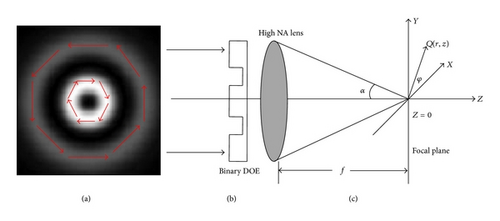
3. Analysis of Binary Phase Plate
When a double-ring-shaped azimuthally polarized beam without any phase modulation is tightly focused, a single-ring focal hole pattern is obtained and is shown in Figure 2(a). We observed that the FWHM of the generated focal hole is 0.782λ and its corresponding focal depth is 4λ. Such a focal ring with subwavelength size can be used for stable trapping of single particle with low refractive index [21]. However, to trap two separates such particles and to manipulate them, we need to split this single-ring focal hole structure to a double ring structure. We observed that this is possible by introducing phase modulation to the input double-ring-shaped azimuthally polarized beam through a 3-belt binary phase plate. We optimized the NA of the first, second, and third ring of the 3-belt binary phase plate as NA1 = 0.1, NA2 = 0.25, and NAmax = 0.9 for β = 1.35 to achieve the above-mentioned task, and the generated focal segment is shown in Figure 2(b). From Figure 2(b), we observed that the single focal hole is splitted into two focal holes, and the FWHM of each focal hole segment is measured as 0.468λ and is separated by the distance of 2.8λ between them. We observed that the residual intensity that exists between the two rings is only 35% of the total intensity measured at the focal hole. The ring focus altered by the BPP can be used to move the trapped particle from one place to another. We also observed that it is possible to increase the separation distance between the two focal rings by setting NA1 and NA2 of the BPP as 0.2, 0.85 and by tuning β = 1.5, respectively. The corresponding focal hole segment generated is shown in Figure 2(c). From the figure we measured that the FWHM of each focal holes is 0.468λ and is axially separated by the distance of 4λ between them. We observed that the residual intensity that exists between the two rings is only 33% of the total intensity measured at the focal hole. It is also possible to achieve 3-ring focal hole segment by setting NA1 and NA2 of the BPP as 0.3, 0.775 and by tuning β = 1.35. The corresponding focal hole segment generated is shown in Figure 2(d). From Figure 2(d), we measured that the FWHM of each focal hole is 0.468λ, and each of them is separated by the distance of 2.8λ. We observed that the residual intensity that exists between the rings is only 31% of the total intensity measured at the focal hole. We observed that by using 5 belts BPP, it is possible to generate double ring focal segments with FWHM of 0.468λ and are axially separated by a large distance of 9.4λ as shown in Figure 3(a).
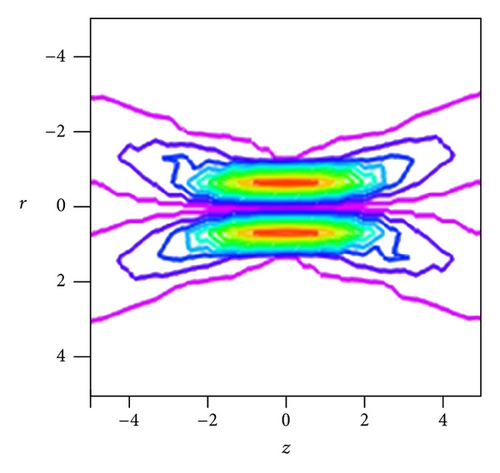
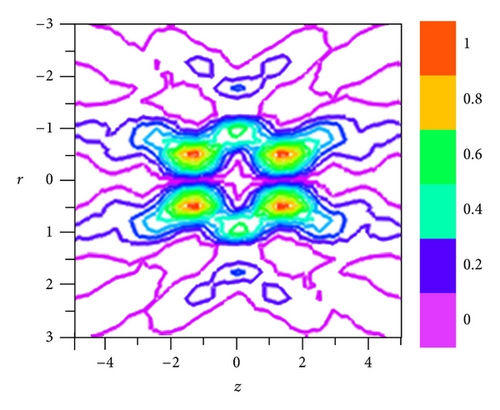

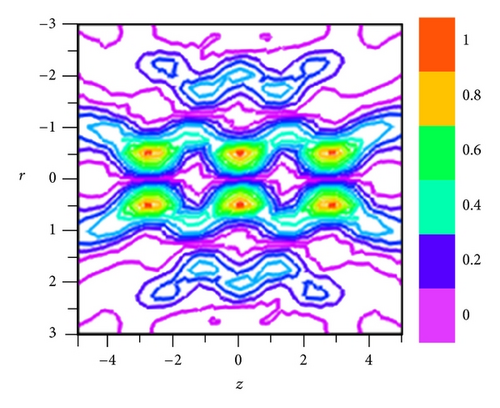
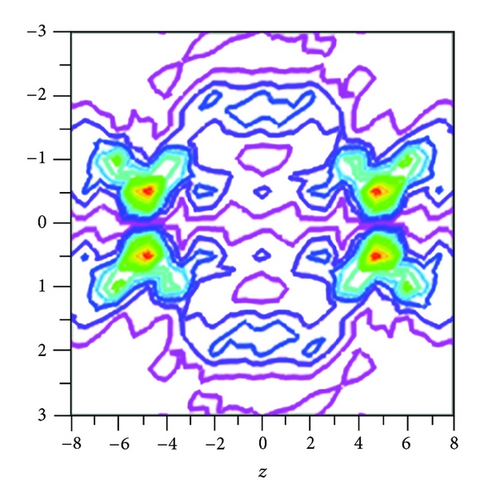
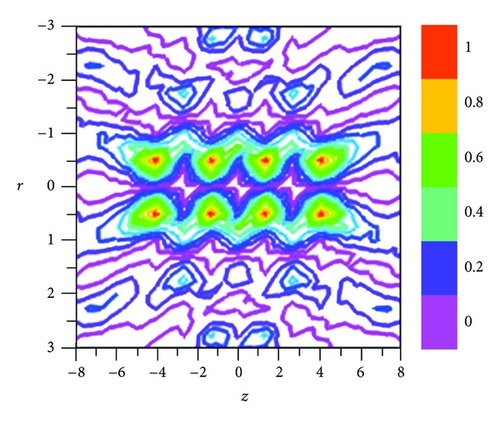
The set of values of NA of BPP optimized to achieve the above-mentioned task is NA1 = 0.34, NA2 = 0.57, NA3 = 0.78, NA4 = 0.85, and NAmax = 0.9 for β = 1.36. From Figure 3(b) we also found that it is possible to generate four-ring patterns having almost uniform FWHM of 0.468λ and are axially separated by the distance of 2.7λ between them by setting NA1 = 0.24, NA2 = 0.354, NA3 = 0.6, NA4 = 0.8, and NAmax = 0.9 for β = 1.3. We observed that the residual intensity that exists between the rings is only 30% of the total intensity measured at the focal hole. Thus with the help of liquid crystal-based tunable BPP, it is possible to generate tunable subwavelength focal hole segment with input double-ring-shaped azimuthally polarized beam.
4. Conclusion
In conclusion, we show by vector diffraction theory that the tight focusing of double-ring-shaped azimuthally polarized beam with a high NA lens and tunable BPP, it is possible to generate many novel focal patterns which are potentially useful for optical trapping and manipulation of low refractive index particles.




